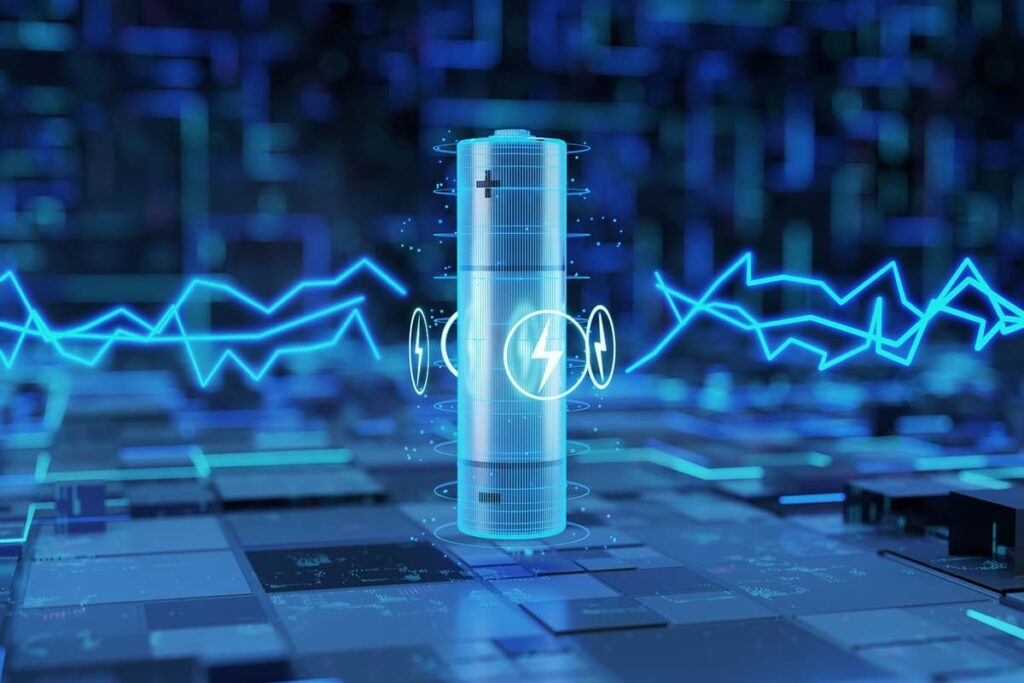How Lithium-Ion Batteries Will Continue to Improve
Table of contents

We’ve recently begun the rather interesting exercise of going through and summarizing the more than 1,600 articles published on Nanalyze since we began waxing poetic almost seven years ago. We were surprised to see that when it comes to grid-scale storage, flow batteries just never really achieved the traction investors were looking for, with more companies failing than not. On the other hand, lithium batteries have made great progress in powering other new technologies like electric cars, drones, and smartphones.
Lots of banter has been flying around lately regarding battery breakthroughs. The Chinese have developed a million-mile battery, and His Excellency Mr. Elon Musk is hinting at some breakthrough involving supercapacitors that’s now expected to be announced in September (that’s about six months later than originally anticipated, mainly because of “the rona“). In the meantime, dozens of startups are working to improve lithium batteries using everything from AI to nanotechnology.
The Last Time We Looked
A few years ago, we looked at some lithium-ion battery tech startups getting funding, a list which included the below names (disclosed funding in italics):
- Farasis Energy ($790 million) – Massive funding, massive aspirations for this battery producer that may look to acquire smaller fish.
- Sila Nanotechnologies ($285 million) – Sila’s new nanomaterial will result in graphite anodes being replaced with silicon anodes for a 10-15% increase in density.
- Quantumscape ($300 million) – Working with Volkswagen on a solid-state battery – no liquids, supposed to be safer and offers increased density.
- Ionic Materials ($65 million) – Flame-resistant solid-state battery which is not only cheaper to produce but also claims a 5 to 10 times increase in energy density.
- Sonnen ($169 million) – Home batteries that use iron as a cathode which offers superior safety features along with better durability. Acquired by Royal Dutch last year.
- SKIO Matrix ($268 million) – Chinese firm offering up a mixed bag of charging stations, electric conversion kits, and batteries.
- Proterra ($482 million) – Trying to challenge China’s BYD with their electric bus offering.
Let’s look at some lithium-ion battery tech startups that have been taking some funding this year along with a bonus – a publicly traded stock that’s working on improving lithium batteries.
The Promise of Silicon Anodes
In looking back at all the companies we’ve looked at that are trying to improve lithium-ion batteries, one theme stands out – silicon anodes. “Welcome to the Era of Supercharged Lithium-Silicon Batteries,” was an article published by Wired this past February which puts it simply. “Batteries with silicon anodes promise to make devices last more than 20 percent longer on a single charge.” Consequently, investors have been pouring money into startups racing to be first-to-market with silicon anodes.

One startup that recently came out of stealth with their own silicon replacement for anodes is ADVANO.
Founded in 2014, New Orleans startup ADVANO has taken in nearly $24 million in funding to solve the notoriously difficult problem of using silicon in place of graphite for battery anodes. The foundation of their technology is an engineered 3D nanostructure that serves as a graphene replacement. In order to produce this material, they plan to use silicon waste that’s a byproduct of manufacturing solar panels or semiconductors. The company came out of stealth last year and is developing their own anode and battery as well.
Backing ADVANO is chemical giant Mitsui along with Peter Thiel and other notable investors who would have had to know about competitors like Nexeon (backed by Invesco and Wacker Chemie, the latter of which recently acquired 25% of the company) and Sila Nanotechnologies (backed by Daimler) who are also developing silicon anodes, and have been doing so for some time. We’re not saying there’s room for more than one solution, but ultimately one of these three startups has the superior solution. According to the “father of the iPod,” Tony Fadell, the key challenges with silicon anodes are “material expansion, cycle life, cost, and drop-in manufacturing scalability.” ADVANO has solved all four, which is why he’s a lead investor in the firm.
There are plenty of other competitors in this space, like Amprius, a firm that’s developing anodes using silicon nanowires, and took an investment from Airbus last year. The company claims “the highest energy density commercial batteries in the industry,” though they don’t say much about what they’ve been up to other than a press release every year or so. The secrecy is understandable given just how much money is pouring into silicon anode startups. Then there’s Enevate, a company that’s more than doubled their funding since we last looked at them, money that’s come from names like Samsung, Lenovo, and LG Chem to develop a battery technology that makes charging electric vehicles as fast as refueling a gas car. In short, there are loads of companies trying to solve the silicon anode puzzle and presumably some big rewards for the winner(s).
One last thing to note on silicon anodes. While researching this piece, we came across an article by Chemical and Engineering News that quotes Lux Research analyst Chloe Holzinger as saying the focus on silicon anodes “is temporary, as we expect lithium-metal anodes to take off in the 2030s.” In other words, lithium-ion battery improvements are expected to continue for at least a few decades.
Silicon Anodes + Increased Capacity
Founded in 2006, Fremont, California startup Enovix has taken in just over $191 million in funding to develop a “3D wave array energy storage system for lithium-ion batteries” with backing from names like Intel and Qualcomm. Instead of developing a drop-in solution for existing manufacturing processes, Enovix appears to be reinventing the entire manufacturing process along with their own 100% silicon anode thrown in for good measure.
Per the company, “Enovix replaces electrode winding in a standard pouch lithium-ion battery production process with proprietary laser patterning and high-speed stacking tools to increase line capacity by 30%.” We don’t understand what the first part means, but everyone can understand the last part – increasing capacity by 30%. The company’s latest round of $45 million which closed this past March will be used to complete their fully automated commercial production line by year-end.
Same Materials, New 3D Structures
Staying on the 3D theme, Israeli startup Addionics has taken in $7 million in funding to develop a “patent-protected scalable 3D metal fabrication method” they believe will enhance performance, mileage, safety, cost, and charging time of batteries. Instead of messing with battery chemistry, Addionics takes known materials used in the production of batteries and fabricating them into a different 3D structure. An article by InsideEVs provides some more details about the technology and says the company is currently talking with battery manufacturers.
Batteries that Use Graphene
We’ve been hearing about how great graphene is for decades now, so we’re happy to see at least a few companies moving forward with graphene for lithium-ion batteries. If Skeleton Technologies can become a leading supplier of ultracapacitors because of graphene, then why not have a similar success story for lithium batteries?
Founded in 2014, Los Angeles startup Nanotech Energy has taken in nearly $40 million in funding to become (in the company’s own words), “the world’s top supplier of graphene.” As we’ve talked about before, there are plenty of graphene suppliers, but not enough commercial products that use the stuff at scale. Over the past three years, Nanotech Energy has been working on the development of a high-performance, non-flammable battery for Daimler Mercedes hybrid and electric automobiles. In May they closed an oversubscribed Series C for $27.5 million, and within the next year, the company is planning to release an environmentally friendly battery that can charge 18 times faster than anything that is currently available on the market. They’re not the only company using graphene to improve lithium batteries.
Founded in 2012, Chicago startup NanoGraf Corporation has taken in around $17 million in funding to develop “silicon-graphene anode materials enable longer lasting, faster charging batteries.” The technology was developed, optimized, and patented in collaboration with researchers at Northwestern University and Argonne National Laboratory. The technology utilizes a wet chemistry process that is highly scalable and already proven in a multi ton-scale pilot manufacturing line in Japan. (In 2018, NanoGraf announced a $5.5 million investment partnership with JNC, a Tokyo-based chemical company.)

The technology promises electric vehicles that can travel 50% farther.
On the topic of graphene, note that there are any number of graphite miners cum graphene suppliers that are working miracles with graphene and just need you on board as an investor to make it all happen. We’ve seen enough of them fail to know that this isn’t something anyone should be investing money in.
Nano One Materials
Lastly, while researching this article we came across an $83 million publicly traded company called Nano One Materials (NNO:CN) which just announced “the development of a coated, single crystal cathode material for lithium-ion batteries that is providing up to 4 times improvement in longevity.” (These latest innovations are patent pending.) We’re excited to hear that, but we’re not big fans of companies that spend valuable resources on “investor relations” instead of focusing on their core competency.
In the media section of the company’s website, you’ll find the results of all this IR outreach – plenty of lesser-known pundits saying positive things about the company and suggesting that it’s an opportunity you need to grab before the train leaves to money town – choo choo!

Then there’s the recent report by Alpha Direct which is listed in the “Media” section of Nano One’s website. Here’s what it says in the fine print of the report.

Any time we see that a publicly-traded firm has decided to go down this path, we recognize it for the red flag that it is and move on. End of story.
We’ve seen countless micro caps issue shares ad infinitum while promising that revenues are just around the corner. There’s nothing wrong with this per se, a company’s ultimate mandate is to survive. However, if you’re a micro-cap company with no revenues that’s issuing shares to survive – and has been for a while – the odds just aren’t in your favor. You can see for yourself that in 2015 when they did a reverse merger with a mining company shell, Nano One had 44,793,599 shares outstanding. Today, that number sits at 78,739,802. Most investors probably have no idea of how this dilution will affect their investment over time. As we always have, we caution against making investments in companies like Nano One Materials.
Conclusion
The car battery makes up about 30% of the total cost of an electric vehicle, so the goal is to improve performance while maintaining or reducing costs and keeping everything green at the same time. There are dozens of startups out there trying to improve upon lithium batteries, and we’ve only covered a handful. Don’t forget that Tesla’s Battery Day in September – provided it doesn’t get moved again – promises us some big news on batteries. All the big producers of lithium batteries aren’t sitting on their laurels, they’re also working on new ways to improve lithium batteries. It’s still anyone’s race to win.
Sign up to our newsletter to get more of our great research delivered straight to your inbox!
Nanalyze Weekly includes useful insights written by our team of underpaid MBAs, research on new disruptive technology stocks flying under the radar, and summaries of our recent research. Always 100% free.





















Actually Nano One Materials is doing great. In June the stock moved up over 100% !
I meant: in July 2020.
Short term price appreciation says nothing about the long term potential of a company. We strongly advise our readers to stay far away from any stock that trades on over-the-counter exchanges. Nano One Materials is no exception.
https://nanalyze.com/investing-penny-stocks-dummies/
QuantumScape reported that testing of three single-layer cells by Mobile Power Solutions, an independent lab, showed that its batteries successfully completed a simulation of how a battery might work in the real world, being roughly equivalent to 240,000 miles driven by a vehicle with a 300-mile range. The testing also proved, it said, that the battery can operate at continuously high charge and discharge rates with minimal degradation.
And if my Aunt Sally had nuts she’d be my uncle. We’ve heard enough about the 1700 different tests they’ve run. Revenues, that’s what we want to see. Revenues.
Nano One is nearing a commercial agreement with their Asian cathode partner, which could yield initial commercial production as early as 2023.
All partnerships are evolving well, and focus is shifting away from technological validation towards commercial scaling as Nano One enters the next stage of its development.
Financials: market cap: CAD $380M, they have no revenues, they have CAD $55M in cash. Based on Q2 results they burn cash at the anualized rate CAD $11M per year. So they have plenty of cash to carry on for the next couple of years.
It looks like we will need to wait for 2 years for any significant revenue.
So in my view: Nano One could be a risky bet, but could become a big win a few years from now.
No revenues, no thanks. Simple.
Sila Nanotechnologies’ has spent the last ten years developing new battery technology, with the Sila battery representing the first marketable fruit of this research.
The company’s innovative battery chemistry uses silicon in its cell’s anode instead of graphite, resulting in a battery with up to 20% more energy density than conventional lithium-ion batteries with a smaller battery footprint.
The development of the new battery focused on commercialization from the outset. As a result, Sila Nanotechnologies has produced a system that can be easily and quickly brought to market, integrating into existing manufacturing and design parameters. These benefits are maintained without compromising the battery’s life cycle, charging performance, or safety.
—
Before Gene Berdichevsky became the co-founder and CEO of battery chemistry company Sila Nano, he was the seventh employee at Tesla Motors. As principal engineer on the Roadster battery, Berdichevsky was one of the first people crazy enough to experiment with shoving a lithium-ion battery pack into a combustion engine vehicle.
QuantumScape, a solid-state battery startup, announced last month (in November) that the final goal of 2021 was achieved ahead of schedule. The goal was related to the longevity of the cell, which should withstand 800 charging cycles, estimated as an equivalent to 240,000 miles (386,000 km) of driving (assuming 300 miles/483 km per charge). An important thing about solid-state battery is fast charging capability. QuantumScape promises 10-80% in 12 minutes.
Ah yes, the never-ending development updates so the people funding this R&D project believe that something is happening with their money. We’re interested in hearing an update as soon as the first revenues start trickling in. That’s when we’ll take another look at QuantumScape.